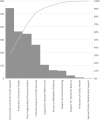The Intersection of Work and Home Challenges Faced by Physician Mothers During the Coronavirus Disease 2019 Pandemic: A Mixed-Methods Analysis
- PMID: 33761277
- PMCID: PMC8182656
- DOI: 10.1089/jwh.2020.8964
The Intersection of Work and Home Challenges Faced by Physician Mothers During the Coronavirus Disease 2019 Pandemic: A Mixed-Methods Analysis
Abstract
Objectives: The coronavirus disease 2019 (COVID-19) pandemic has presented extreme challenges for health care workers. This study sought to characterize challenges faced by physician mothers, compare differences in challenges by home and work characteristics, and elicit specific needs and potential solutions. Methods: We conducted a mixed-methods online survey of the Physician Moms Group (PMG) and PMG COVID19 Subgroup on Facebook from April 18th to 29th, 2020. We collected structured data on personal and professional characteristics and qualitative data on home and work concerns. We analyzed qualitative data thematically and used bivariate analyses to evaluate variation in themes by frontline status and children's ages. Results: We included 1,806 participants in analysis and identified 10 key themes. The most frequently identified need/solution was for Community and Government Support (n = 545, 47.1%). When comparing frontline and nonfrontline physicians, those on the frontline more frequently raised concerns about Personal Health and Safety (67.8% vs. 48.4%, p < 0.001), Organizational Communication and Relationships (31.8% vs. 23.8%, p < 0.001), and Family Health and Safety (27.2 vs. 16.6, p < 0.001), while nonfrontline physicians more frequently addressed Patient Care and Safety (56.4% vs. 48.2%, p < 0.001) and Financial/Job Security (33.8% vs. 46.9%, p < 0.001). Participants with an elementary school-aged child more frequently raised concerns about Parenting/Homeschooling (44.0% vs. 31.1%, p < 0.001) and Work/Life Balance (28.4 vs. 13.7, p < 0.001), and participants with a preschool-aged child more frequently addressed Access to Childcare (24.0 vs. 7.7, p < 0.001) and Spouse/Partner Relationships (15.8 vs. 9.5, p < 0.001), when compared to those without children in these age groups. Conclusions: The physician workforce is not homogenous. Health care and government leaders need to understand these diverse challenges in order to meet physicians' professional and family needs during the pandemic.
Keywords: COVID-19; mothers; occupational stress; physicians; women; work-life balance.
Conflict of interest statement
M.C.H. is supported by the NIH (3U01HG010218-03S2-03S2 and 5UL1TR003142-02). K.S.M. is supported by the NIH (K23HL130648 and U01HL122998) and serves on the BREATHE Trial Steering Committee supported by Roivant/Kinevant Sciences. L.C.D. is supported by the NIH (P30 CA008748 and K07 CA184037). She receives author royalties for a textbook published by Multilingual Matters, an imprint of Channel View Publications, on the topic of language barriers in health care. U.S. is supported by the NIH (K24CA212294). She has received grant funding for unrelated work from NIH, the Agency for Health care Research and Quality, U.S. Food and Drug Administration, The California Health Care Foundation, Blue Shield of California Foundation, the Gordon and Betty Moore Foundation, and the Commonwealth Fund. She is also supported by an unrestricted gift from the Doctors Company Foundation and holds contract funding from She holds contract funding from AppliedVR, InquisitHealth, and Somnology. She serves as am uncompensated scientific/expert advisor for nonprofit organizations HealthTech 4 Medicaid and HopeLab. She has been a clinical advisor for Omada Health, and an advisory board member for Doximity. C.M. is supported by several grants including the National Institutes of Mental Health (R01MH112420), Genentech, the Doris Duke Charitable Foundation (Grant 2015211), the California Health Care Foundation. She is a founding member of TIME'S UP Healthcare, but receives no financial compensation from that organization. In 2019, she received one-time speaking honoraria from Uncommon Bold. M.K.G. is supported by the NIH (R01HD070910, R03MD011654). R.J. has stock options as compensation for her advisory board role in Equity Quotient, a company that evaluates culture in health care companies; she has received personal fees from Amgen and Vizient and grants for unrelated work from the National Institutes of Health, the Doris Duke Foundation, the Greenwall Foundation, the Komen Foundation, and Blue Cross Blue Shield of Michigan for the Michigan Radiation Oncology Quality Consortium. She has a contract to conduct an investigator initiated study with Genentech. She has served as an expert witness for Sherinian and Hasso and Dressman Benzinger LaVelle. She is an uncompensated founding member of TIME'S UP Healthcare and a member of the Board of Directors of ASCO. E.L. is supported by the NIH (grants DP2CA225433 and K24AR075060).
Figures


References
-
- Shanafelt T, Ripp J, Trockel M. Understanding and addressing sources of anxiety among health care professionals during the COVID-19 pandemic. JAMA 2020;323:2133. - PubMed
Publication types
MeSH terms
Grants and funding
LinkOut - more resources
Full Text Sources
Other Literature Sources
Medical
Miscellaneous

